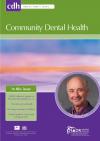Community Dental Health

- Cover Date:
- June 2016
- Print ISSN:
- 0265 539X
- Vol:
- 33
- Issue:
- 2
A bi-level intervention to improve oral hygiene of older and disabled adults in low-income housing: results of a pilot study
Objective: This paper describes the results of a bi-level intervention, using a cognitive-behavioral theoretical approach, to improve the oral hygiene of older adults and the disabled in community-based low income senior housing. Methods: The bi-level pilot intervention consisted of an on-site tailored adapted motivational interviewing (AMI) session and two oral health fairs, supported by a resident campaign committee, to change community norms. All materials were available in English and Spanish. Participants completed a survey consisting of 12 domains that provided the basis for tailoring the AMI and shaping the campaigns. The domains were activities of daily living (ADLs), access to oral health information, oral hygiene status, dental knowledge, hygiene behaviors, importance of oral hygiene, self-efï¬cacy/locus of control, diet, intentions, self-management worries/fears, perceived risk and dry mouth. Main Outcome Measures: Each participant received clinical assessments consisting of full-mouth plaque score (PS) and gingival index (GI) before the intervention and at three months. Results: Twenty-seven residents with at least one tooth completed all phases of the study. The mean number of domains requiring attention was 4.5 (SD 1.6) with a range of one to seven. Mean baseline PS was 83% (SD 16%) which improved signiï¬cantly to 58% (SD 31%); mean baseline GI was 1.15 (SD 0.61) and improved signiï¬cantly to 0.49 (SD 0.46). Conclusions: This pilot study supports the feasibility and acceptability of a tailored oral hygiene intervention among older and disabled adults living in low income senior housing. Although a small
sample, the study demonstrated signiï¬cant improvements in both plaque and gingival scores three months after the bi-level intervention.
Key words: oral health, older adults, adapted motivational interviewing, motivational interviewing, America
doi:10.1922/CDH_ 3864Reisine06
- Article Price
- £15.00
- Institution Article Price
- £
- Page Start
- 127
- Page End
- 132
- Authors
- S. Reisine, J.J. Schensul, R. Goldblatt, K. Radda, C. Foster-Bey, C. Acosta-Glynn, L. Miron-Carcamo, E. Ioannidou
Articles from this issue
- Title
- Pg. Start
- Pg. End
- Child oral health in migrant families: A cross-sectional study of caries in 1-4 year old children from migrant backgrounds residing in Melbourne, Australia
- 100
- 106
- Feasibility, utility and impact of a national dental epidemiological survey of three-year-old children in England 2013
- 116
- 120
- A bi-level intervention to improve oral hygiene of older and disabled adults in low-income housing: results of a pilot study
- 127
- 132
- Caries and costs: an evaluation of a school-based fluoride varnish programme for adolescents in a Swedish region
- 138
- 144
- Examiner reliability in fluorosis scoring: a comparison of photographic and clinical methods
- 145
- 150
- Do ‘poor areas’ get the services they deserve? The role of dental services in structural inequalities in oral health
- 164
- 167
